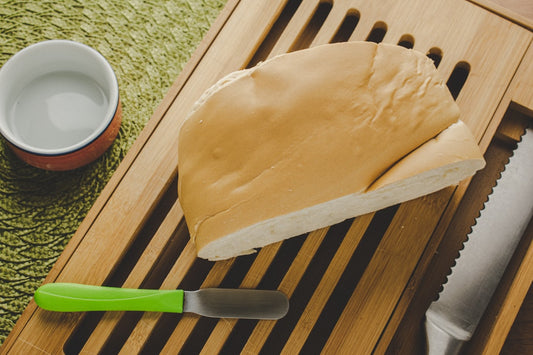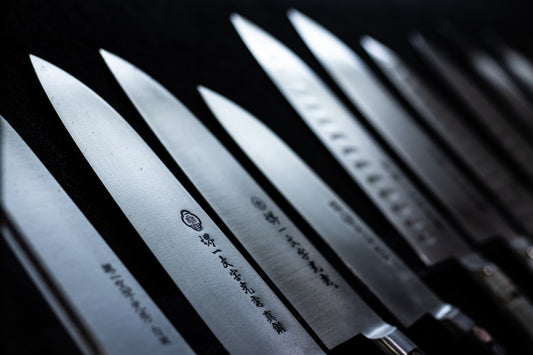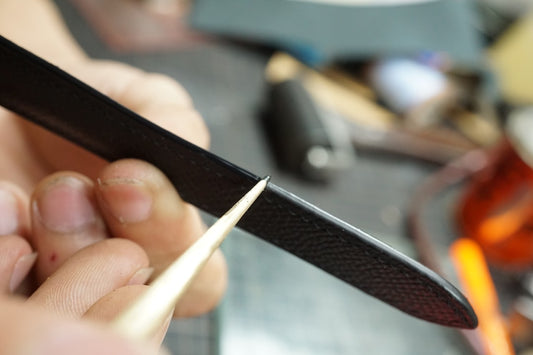
Share
Finding Your Perfect Edge: Affordable Japanese Knives for Home Cooks
Estimated Reading Time: 10 minutes
Key Takeaways
- Affordable Japanese knives bring centuries of craftsmanship to home kitchens with tools designed for precision and durability.
- Understanding blade types, materials, and handle styles helps you select the right knife for your cooking style.
- Trusted sources and authentic retailers are essential to ensure genuine quality and avoid counterfeit products.
- Regular care and sharpening preserve blade performance and honor the tradition embedded in every knife.
- Investing in a quality Japanese knife supports a meaningful culinary journey, blending history with modern cooking.

Understanding Japanese Knives – A Heritage of Craftsmanship
Japanese knives are more than culinary tools: they are living artifacts, shaped by disciplines inherited from samurai swordsmiths and prized by chefs around the globe. To appreciate affordable Japanese knives for home cooks, we must first look beneath the blade and into the traditions of Japanese steel and craftsmanship.
The Legacy of Japanese Steel
Centuries ago, bladesmiths in Sakai, Seki City, and other storied regions began forging weapons for samurai using tamahagane—high-grade steel created in ancient tatara furnaces. Those very forging techniques, tested in time and battle, endure today not for warfare, but for harmony in the kitchen.
- Hardness & Edge Retention: Japanese steel is refined, hard, and packed with a fine-grained structure. This gives each knife superior sharpness and lasting edges compared to most Western knives.
- Lightness & Precision: Japanese blades are typically thinner and lighter, offering unmatched precision in every cut—from filleting fish to chiffonading herbs.
Explore more about the Japanese knife craftsmanship history to deepen your appreciation of these blades.
Regional Styles and Cultural Distinction
- Sakai: Famed for sushi and sashimi knives, with an emphasis on razor-thin, single-bevel edges.
- Seki City: The heartland for versatile chef’s knives blending old-world forging with modern techniques.
- Echizen: Known for traditional hand-forging and bold aesthetics.
These regions are the wellspring for many premium Japanese knife brands USA enjoys today—such as Shun, Yoshihiro, and MAC, each embodying the legacy of their hometowns. Behind every premium blade stands a master blacksmith, often anonymous, who brings history alive through steel.
Delve into the Japanese knife forging process for a full view of traditional techniques shaping these legendary knives.
Forged vs Stamped
- Forged Knives: Hand-shaped and hammered, offering durability, character, and tradition.
- Stamped Knives: Machine-cut from single sheets, lighter and more affordable, but generally less robust and full of personality.
Japanese steel and master forging endure not out of nostalgia, but because they deliver real advantages for cooks, both at home and in professional kitchens. Now, let us explore how this tradition translates into practical decisions for your kitchen.
Choosing the Right Knife – Key Factors for Home Cooks
Choosing among affordable Japanese knives for home cooks means understanding the knife’s anatomy, your own culinary rhythms, and how modern needs can harmonize with age-old wisdom. Here are the essential elements to guide your decision:
Key Japanese Knife Profiles
Every cooking style deserves a blade that feels like an extension of the hand.
-
Gyuto (Chef’s Knife):
- All-purpose.
- Ideal for meat, fish, and vegetables.
- Curved belly allows rocking motion.
-
Santoku:
- “Three virtues”—meats, fish, vegetables.
- Shorter, lighter, straighter edge for push-cutting.
- Popular among home cooks for versatility.
-
Nakiri:
- Vegetable specialist.
- Flat edge for clean, downward cuts.
- Great for precise, delicate work.
-
Petty:
- Compact utility.
- Best for peeling, trimming, and smaller foods.
Learn more details on each style in our Japanese chef knife types guide.
Blade Materials: High-Carbon Steel vs Stainless Steel
Each has its own discipline.
-
High-Carbon Steel:
- Exceptionally sharp.
- Holds an edge longer.
- Requires more care—prone to rust if neglected.
-
Stainless Steel (e.g., VG10, AUS-8):
- Corrosion-resistant.
- Easier maintenance.
- Slightly softer but friendly for busy kitchens.
For a detailed look at these materials and how they impact performance and care, visit Japanese knife anatomy.
Construction Styles: Single Bevel vs Double Bevel
-
Single Bevel (often found on sushi/sashimi knives):
- Sharper, allows for highly precise cuts.
- Generally for right-handed users (left-handed available but rare).
- Demands more skill to use and maintain.
-
Double Bevel:
- Versatile, symmetrical.
- Easy for both right- and left-handed cooks.
- Most common in home-use Japanese knives.
We also explore bevel types in the Wa-style vs Yo-style knives guide.
Handle Types—Wa vs Yo Handles
- Wa handle: Traditional Japanese. Lightweight, round or octagonal, usually wood. Balances delicacy with control.
- Yo handle: Western-style. Heavier, with a defined bolster, offering a familiar feel for those used to European knives.
Self-Inquiry: What do you cook most?
- Lovers of vegetables may gravitate to nakiri.
- Adventurous all-round cooks may favor gyuto or santoku.
Discover more about handle styles and blade parts in Japanese knives blade grind types and anatomy.
Practical Tips
- Left-Handed Users: Look for ambidextrous (double-bevel) knives, or specifically left-bevelled models.
- Weight and Cuisine: Heavier knives are suited for Western cuts (roasts, squash), while lighter, thinner profiles shine with sushi and vegetables.
Choosing a knife is an act of self-respect—a statement of intent as you begin shaping every meal. As you decide, know you’re joining a lineage of craftspeople, each selecting their blade with purpose.
Best Japanese Chef Knives 2025 – A Curated Selection
Finding the best Japanese chef knives 2025 means balancing performance, tradition, and affordability. Here are top value-for-money picks, selected for their reliability in home kitchens and availability from premium Japanese knife brands USA trusts.
Top Picks by Budget
Under $100
-
Tojiro DP Gyuto (8") – Culinary School Favorite Under $100
- Steel: VG10 core, stainless cladding.
- Edge: Double-bevel, easy maintenance.
- Handle: Western-style (Yo).
- Why we love it: Professional edge at an entry price; often used in culinary schools.
“After many months, it’s still razor-sharp. I never imagined a $70 knife could feel this good.”
– Sarah, enthusiastic home cook
$100–$200
-
Ōkami Blades Classic Santoku – Balanced Performance for Every Cook
- Steel: High-carbon Japanese steel.
- Edge: Polished double-bevel, ambidextrous.
- Handle: Wa-style, hand-shaped.
- Why we love it: Perfect for beginners and experts. Lightweight with powerful, controlled cuts.
“This Santoku is the heart of my kitchen. Prepping stir-fry is now a joy.”
– Kenji, home chef -
MAC Professional Series Chef’s Knife (8")
- Steel: Proprietary high-carbon blend.
- Edge: Slightly curved (good for rocking).
- Handle: Pakka wood, comfortable grip.
- Why we love it: Slices through meats and vegetables with ease; durable and forgiving.
$200+
-
Shun Classic 8" Chef’s Knife – Trusted Japanese Brand Known in USA
- Steel: VG-MAX—ultra-sharp and stain-resistant.
- Edge: Double-bevel, hand-finished.
- Handle: D-shaped pakkawood.
- Why we love it: Reliable, elegant, and recognized as a gold standard among premium Japanese knife brands USA.
-
Yoshihiro VG10 Damascus Chef’s Knife
- Steel: VG10 core, 16-layer Damascus pattern.
- Edge: Double-bevel, mirror-polished.
- Handle: Wa style—octagonal.
- Why we love it: Traditional aesthetics meet reliable function—often found under $210 online.
More on these selections and their features is available in our Best Japanese Chef Knives 2025 guide.
Comparison Table: Best Japanese Chef Knives 2025
| Brand (Model) | Steel | Edge & Bevel | Handle Type | Price Range | Notable Features |
|---|---|---|---|---|---|
| Tojiro DP Gyuto | VG10 | Double, 8" | Yo | $70–$90 | All-rounder, pro-level value |
| Ōkami Blades Classic Santoku | High-carbon | Double, 7" | Wa | $120–$150 | Lightweight, artisan finish |
| MAC Pro Series Chef | Proprietary blend | Double, 8" | Yo | $145–$170 | Forgiving, sharp, top choice in USA |
| Shun Classic Chef | VG-MAX | Double, 8" | Yo | $160–$200 | Award-winning design, hand-finished |
| Yoshihiro VG10 Damascus | VG10/Damascus | Double, 8" | Wa | $200–$220 | Traditional look, modern performance |
Each of these knives is available through well-regarded US suppliers. Most importantly, these represent a commitment to both quality and accessibility—ensuring your first Japanese knife is also your best investment.
Discover the full range of chef-proven blades with Ōkami Blades.
Where to Buy: Trusted Sources Online
Buying a Japanese knife should be thrilling, not risky. With demand rising, so too has the presence of imitation blades and knock-offs. Knowing where to buy Japanese knives online ensures you receive an authentic tool with integrity and support.
Risks of Unverified Sellers
Large marketplaces sometimes disguise factory seconds or counterfeits as the real thing. Stories abound of buyers opening a package to find a dull, poorly finished blade masquerading as a premium Japanese knife. Some even receive knives rusted in transit, without proper packaging or support.
True Story
Maya, a home chef from Portland, purchased a “bargain” set from a little-known online store. Upon arrival, the knives were light, easily chipped, and the steel tarnished after just one use. The brand, though bearing a Japanese name, turned out to have no heritage or warranty.
Where to Buy Japanese Knives Online: Recommended Retailers
For Beginners:
- Ōkami Blades – Curated Japanese steel, original designs, educational support.
- Japanese Knife Imports – Reputable LA-based shop with excellent starter selections.
For Advanced Home Cooks:
- Korin (NYC and online) – Sought-after by professionals, deeper selection of artisan lines.
- Knife Merchant – Wide selection, competitive pricing, trusted by culinary students.
For Budget-Conscious Shoppers:
- Amazon-authorized sellers – Only those explicitly listed as “Authorized Dealer” for the brand. Exercise caution and verify before purchasing.
How to Vet a Vendor
- Return Policy: Transparent, risk-free returns signal seller integrity.
- Shipping: US-based warehouses reduce shipping risk and wait times.
- Customer Support: Look for knowledgeable, reachable support staff—before and after sale.
- Education: Does the site help you learn about knife care, proper use, and maintenance?
Learn how to avoid counterfeits and authenticate blades properly in our How to Authenticate Genuine Japanese Knives post.
Ōkami’s online store is crafted as a safe haven—every blade is authenticated, supported, and paired with resources for your continued growth.
Begin your journey with confidence – shop direct with Ōkami Blades.
Japanese Knife Price Comparison – Balancing Quality and Budget
Understanding the Japanese knife price comparison landscape empowers you to make a decision based on value, not just price. Affordable Japanese knives for home cooks are more accessible than ever, thanks to advances in global shipping and technology.
Price Tiers at a Glance
| Price Range | Typical Features | Brands/Models (Examples) |
|---|---|---|
| $50–$100 | Factory-finished, robust, intro-level steels, mass-produced | Tojiro DP, Victorinox Japanese line |
| $100–$200 | Superior finishes, VG10/High-carbon steels, balance of hand/machine finish | Ōkami Blades Classic, MAC Pro |
| $200+ | Hand-forged, layered Damascus, artisan polish, heritage brands | Shun Premier, Yoshihiro VG10, Masamoto |
What You Get at Each Level
-
Low ($50–$100):
- Basic Japanese steel, solid performers.
- More likely machine-made/stamped.
- Functional, reliable entry for new users.
-
Mid ($100–$200):
- Better steel (e.g., VG10), hand-polished, improved edge retention.
- Ergonomic handles (Wa/Yo), diverse profiles.
- Often includes starter warranty.
-
High-End ($200+):
- True artisan blades—hand-forged, layered Damascus, fine attention to every detail.
- Unique handle woods, custom finishes.
- Lifetime warranties common.
Made easier to navigate with a detailed breakdown in the Premium Japanese Knife Brands USA post.
Modern Accessibility: 2025 and Beyond
In 2025, affordable Japanese knives for home cooks are no longer rare. Improved steel-making, refined global logistics, and increased demand have brought these coveted tools to kitchens everywhere.
- Smart Buys: Seek models that focus on blade integrity and edge performance, rather than low cost alone.
- Long-Term Value: One well-made knife will outlast – and outperform – several cheap blades that dull or chip. This is especially true for premium Japanese knife brands USA has access to.
Empower yourself: the price is not just for the steel, but for the story, longevity, and pride you’ll carry into every meal.
The Art of Blade Mastery – Empowering Every Home Cook
A Beginner's Journey
Picture this: Mia, a new cook, unboxes her Ōkami Santoku. Her first efforts are cautious; her knife moves slowly, slicing carrots and onions with measured care. A few weeks pass. Slices grow neater, thinner; her movements gain rhythm. She feels, maybe for the first time, that cooking is not just a skill, but a craft—a daily ritual.
Knife Care: Ritual and Respect
Blade mastery is not only in the slice, but in careful maintenance:
- Cleaning: Hand wash with gentle soap; avoid the dishwasher.
- Sharpening: Use a Japanese whetstone (waterstone). Start with a coarse grit for dull blades; finish with a finer stone for polish.
- Honing: Regularly use a honing rod to keep the edge aligned.
- Storage: Use a magnetic strip or wooden sheath (saya) to protect both blade and fingers.
Explore detailed guides on how to sharpen Japanese knives, the difference between honing steel vs ceramic rod, and the best Japanese knife cleaning tips.
In Japanese kitchen culture, a sharp knife is a sign of care—toward the ingredient, the cook, and those who will soon share the meal. There is beauty and mindfulness in each stroke, a quiet nod to every bladesmith whose fingerprint lives in the steel.
Next Steps on Your Path
- Watch slicing and dicing tutorials to develop your skills.
- Practice with a variety of produce—onions, tomatoes, herbs.
- Explore culinary communities for tips, inspiration, and camaraderie.
For hands-on skills on using different blades effectively, see Mastering Proper Slicing Technique with Gyuto and How to Julienne Vegetables with Santoku.
Owning a Japanese knife is not a mere purchase; it’s a meaningful bridge to hundreds of years of mastery. Every home cook can walk this path—every hand is worthy.
Conclusion
Affordable Japanese knives for home cooks are no longer the privilege of a chosen few—they are flowing into kitchens where passion and purpose meet. With this guide, you have learned how centuries-old artistry can serve your everyday table, which blade best fits your cooking rhythm, and how to step confidently toward trusted sources, balancing value and vision in every purchase.
From exploring the best Japanese chef knives 2025 to gaining clarity on Japanese knife price comparison, remember: every kitchen story can begin anew with the right edge. Trust in the heritage and future of Ōkami Blades—tools forged for those who respect both tradition and today.
You are not simply buying a knife. You are investing in an experience that grows with you—a spark of artistry hidden within every meal.
Begin Your Journey: Shop the Craft
Explore Ōkami Blades’ curated selection—each knife ready to become the centerpiece of your mastery.
Shop the Craft – Ōkami Blades Knives for Every Master in the Making
- Subscribe to our newsletter for buyer’s guides, culinary technique articles, and tips for care and sharpening.
- Gift a blade: share affordable Japanese excellence with someone you love.
- Join our global family of cooks and artisans—start your legacy with the right tool today.
At Ōkami, we honor every reader, every meal, and every journey. Mastery begins with a single, purposeful cut. Welcome to the sharpest chapter in your kitchen’s story.
Frequently Asked Questions
What is the difference between forged and stamped Japanese knives?
Forged knives are hand-shaped and hammered, often offering greater durability and character. Stamped knives are cut from a single sheet by machine, generally lighter and more affordable but usually less robust.
How do I choose the right Japanese knife for home cooking?
Consider your cooking style, preferred blade profile (like gyuto, santoku, nakiri), steel type, bevel construction, and handle feel. Learning about these helps match a knife to your needs.
Where can I buy authentic Japanese knives online?
Purchase from trusted retailers with clear return policies and positive reputations, such as Ōkami Blades, Japanese Knife Imports, Korin, or authorized sellers on Amazon, verifying authenticity before purchase.
How should I care for and maintain a Japanese knife?
Hand wash knives carefully, sharpen regularly with whetstones, hone edges as needed, and store blades properly to protect sharpness and prevent damage.
Why are some Japanese knives more expensive than others?
Price reflects steel quality, craftsmanship, forging techniques, handle materials, and brand heritage. Higher-end knives often offer superior performance, longevity, and unique aesthetics.
Can left-handed users find suitable Japanese knives?
Yes. Left-handed users should look for ambidextrous double-bevel knives or models specifically crafted with left-beveled edges.


